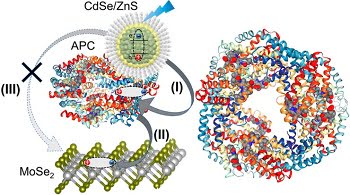Taking notes from the light-harvesting protein complex of plants and certain bacteria, scientists from the U.S. Department of Energy’s Brookhaven National Laboratory and Stony Brook University have assembled a nanohybrid structure that contains both biologically derived and inorganic materials. The researchers combined a light-harvesting protein from a cyanobacteria with quantum dots and a 2D semiconducting transition metal only one atomic layer thick. This nanostructure could be used to improve solar cell efficiency.

When the system is excited with
light (blue lightning strike symbol), energy is transferred in a stepwise
manner through the different components, as indicated by the gray arrows. A top
view of the APC protein structure is shown on the right. Courtesy of Brookhaven
National Laboratory.
When designing the nanohybrid, the scientists selected atomically thin 2D molybdenum diselenide (MoSe2) as the platform for bottom-up assembly. They combined the MoSe2 semiconductor with two strong light-harvesting nanomaterials, quantum dots (QDs), and the allophycocyanin (APC) protein, taken from cyanobacteria.
The components’ bandgaps were engineered such that a concerted stepwise energy transfer could be promoted through the nanohybrid in a directional manner. In the hybrid, energy flows from light-excited QDs to the APC protein, and then to MoSe2, mimicking the natural light-harvesting systems where surface chromophores (in this case, QDs) absorb light and direct the harvested energy to intermediate chromophores (here, APC), and finally to the reaction center (MoSe2).
To combine the different components, the scientists applied electrostatic self-assembly, a technique that uses interactions between electrically charged particles. They then used a specialized optical microscope to analyze the transfer of energy through the nanohybrids. These measurements revealed that the addition of the APC protein layer increased the efficiency of energy transfer by 30%.

They also measured the photoresponse of the nanohybrid incorporated into a fabricated FET and found that it showed the highest responsivity relative to FETs containing only one of the components, producing more than double the amount of photocurrent in response to incoming light.
"More light is transferred to MoSe2 in the biotic-abiotic hybrid," said researcher Mingxing Li. "Increased light transfer combined with the high charge carrier mobilities in MoSe2 means more carriers will be collected by the electrodes in a solar cell device. This combination is promising for boosting device efficiency."
The scientists proposed that adding APC in-between QDs and MoSe2 creates a funnel-like energy-transfer effect caused by the way APC preferentially orients itself relative to MoSe2.
"We believe this study represents one of the first demonstrations of a cascaded biotic-abiotic nanohybrid involving a 2D transition-metal semiconductor," said Li. "In a follow-on study, we will work with theoreticians to more deeply understand the mechanism underlying this enhanced energy transfer and identify its applications in energy harvesting and bioelectronics."
"Today's best solar panels can convert nearly 23% of the sunlight they absorb into electricity, but on average, their efficiency ranges between 15 and 18%," said materials scientist Mircea Cotlet. "If this efficiency can be boosted, more electricity can be generated," she said. "The assembled biotic-abiotic nanohybrid shows enhanced harvesting of light and generation of electrical charge carriers compared to the 2D semiconductor-only structure. These properties increase the nanohybrid's response to light when the structure is incorporated into a field-effect transistor (FET), a kind of optoelectronic device."
The research was published in ACS Photonics (https://pubs.acs.org/doi/10.1021/acsphotonics.9b00090).